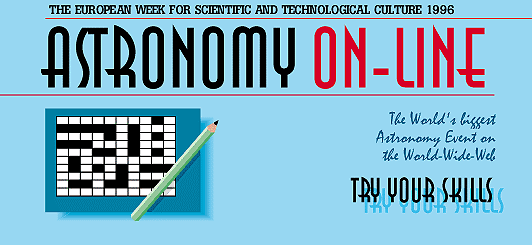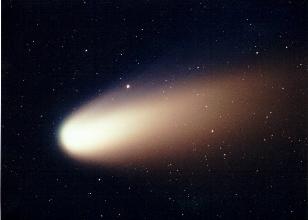 |
Comet Hale Bopp develops even better than optimistic predictions; quoting Daniel Green, IAU:
"I predict that this could be the most viewed comet in all of human history"
 JPEG 68k
JPEG 68k
Student Photo, Data: 4
minutes unguided, on the new, fast Fuji HG 800 Press film. Optics:
5" APO, P.B. mounted on user retrained 16" LX200 SCT -
Sønderborg.
Following the very successful events around the Astronomy On-Line programme late last year, we here propose a continuation with some useful and exciting possibilities for school students in connection with the very bright and beautiful Comet Hale-Bopp.
A lot of exciting amateur images have been published; visiting e.g. the JPL NASA Comet Hale Bopp homepage is a must. There you can find a treasure of very useful photographic advices.
Also, the Comet Live Homepage is interesting, with a lot of continuously updated links.
You should not hesitate to photograph the comet, a fast film (e.g. Fuji HG800) - and even a rigid mount may give astonishing results. Bring your camera out in the dark countryside, and keep the shutter open for 20-40 sec (50 mm) - or 40-60 sec (28 mm camera lens).
Interesting photographic advices may be found in The Amateur Scientist Homepage of Scientific American, or the comet homepage on Sky & Telescope. Valuable low tech and low cost photo advices may also be found at High School Homepage of Bill Drennon.
Whether you photograph the comet with a rigid mount, barndoor-drive or even professional equipment, we are interested in your photos. Send these as scanned images by e-mail to anders@astro.su.se (or hard copy to address: Mogens Winther, Amtsgymnasiet, Grundtvigsalle 86, DK-6400 Sønderborg, Denmark or Anders Västerberg, Saltsjöbadens Samskola, Samskolevägen 1, S-133 34 Saltsjöbaden, Sweden as soon as possible, and we will display these on the Astronomy On-Line L web pages. Remember to include full name, day and time of exposure.
If you apply a wide angle photo camera (e.g. 28-50 mm) you may get best results with e.g. an old oak tree or similar in front. Avoid photographing in areas with electrical poles and light pollution.
An animated finding chart is available here.
Now follow three exercises on which you may try your skills! Together they illustrate the type of observations and measurements which are possible on comets, without much prior knowledge about comets and without complex instruments!
The colour film picture on top of this page was taken on March 9 by Danish AOL students and amateurs. This image has a field of view equal to 1.8 deg x 1.2 deg.
Print the image above. Measure the image scale, e.g. how many centimeters corresponds to 1.2 degrees (vertical size)?
Now take a centimeter-ruler and measure the diameter of the comet head (coma). Convert your measurements to degrees. What is the angular diameter of this coma?
During these exposures, the comet was 1.4 Astronomical Units from planet Earth.
Applying the well known tangens formula :
![[tangens.gif]](tangens.gif)
you may find the coma diameter of Comet Hale Bopp. You can show that this comet coma is huge, compared to planet Earth (diameter = 12 600 km). The coma of comets are usually 20 000 - 200 000 km across. Compare your results, is Hale Bopp a big comet (in this sense)?
Compare with the historical record - the comet of 1811 - having a coma diameter of 1 800 000 km.
Also the tail size of Hale Bopp is huge, 100 million km - to be compared with the 1811 record of 160 million km.

Drawing of the huge Comet 1577
Irrespective of the very often dramatic appearances, these comet comas are merely of very low density.
As our first photo above indicated, there are 2 tail components, a blue one (the gas or ion tail) - as well as a yellow one. The latter yellow tail is called "dust tail". As the name says, it contains dustlike components of ice/stone. This kind of material may later give rise to meteor showers.
Measure the tail length of comet Hale Bopp. Remember, if you keep your hand out in full arm's length, it will suspend an angle of 10 degrees. You do this best away from any light pollution. You may even want to estimate the comet tail length yourself. Contact us for further details (see the email address below).
Estimate the total magnitude of the comet. Due to the brightness of the comet there are few objects to compare with its magnitude. Sirius (magnitude -1.5), Mars (-1.2) and Vega (0.0) may be used in the evening, while Jupiter (magnitude -2.0) is in the morning sky during March. Remember that you must try to estimate the total magnitude of the comet, including the tail. You must also have as little light pollution as possible also for this.
Simultaneous estimates from different locations around the world of the length of the tail and the total magnitude of the comet may give interesting information about the conditions for optical astronomy at different locations. Report your tail length results, impressions etc. to the European Student Project Group. By clicking, you will get our mailservers.
Karen Meech, University of Hawaii, has a most interesting page concerning historical comets.
Looking back, a lot of superstition has followed proceeding comets. Even in recent time, during the Halley appearance in 1910, the detection of various gases in the comet tail gave rise to panick. Newspapers and magazines were full of dreadful stories, showing people poisoned in the streets by e.g. comet Carbon Monoxyde and HCN (Cyanic Acid) gases:
![[cometgas.jpg]](cometgas.jpg)
From the 1910 book by Camille
Flammaron:
Of course, the thinning (dilution) factor is huge in space, very far below any danger treshold. However, the interesting media havoc may be found in links like the Comets in Folklore article and well illustrated books like Ann Druyan's and Carl Sagan's Comets (Ballantine, $16.00). Some 500 pages long, the text covers the lore, people, and science behind our understanding of comets, brought up to date 1997.
List of chemical components
As described by Karen Meech however, the present Comet Hale Bopp contains a lot of exciting molecules, some of which detected for the first time ever in a comet.
Recent updates and many other links may be found on ESO-s Hale Bopp Homepage. You should also take a look at the funny dry ice receipt by Dennis Schatz: Making a Comet in your Classroom.
Let us try to draw the orbit of this comet object. Comets move usually in elliptical orbits:
These orbits may be drawn, in case you know the first two of the following values:
a = the length of the major axis.
b = the length of the minor axis.
e = the eccentricity.
Mostly, the official tables with comet orbital parameters do not provide values of a and b. However, with a bit of math, you may easily calculate these values yourself.
The comets closest approach to the sun, q, is called the perihel distance.
![[ell2.gif]](ell2.gif)
From the figure above, you find
q = a - ea.
q = 0.9141189 Astronomical Units. (1 AU = 149,6 million km).
The eccentricity e = 0.9950842
Knowing two of the components in q = a - ea - you may now calculate the unknown major elliptical axis a.
It is possible - with some math - to show that the minor axis b fullfills
![]()
Now, you may find both a and b.
Having done this, draw the orbit of comet Hale Bopp. As comparison, draw the orbits of the outer planets - and (possible on same scale?) the inner planets. As this exercise clearly shows, the outer turn-point of this comet lies in the huge distance of approximately 2 times a.
Optional Exercise: Repeat the calculations for the 1996 comet Hyakutake: e = 0.999, q = 0.230 AU.
Kepler once demonstrated, that all planets have an orbital period T fullfilling:
![]()
This is also valid for our planet Earth, and here the major
axis a is close to 1 AU. The orbital period, the time needed for one
orbit-move - is in our own case equal to one year. So, in our own
units, we get:
![]()
Knowing the value of our constant, you may enter the value of a for comet Hale Bopp. Doing so, you may calculate the orbit-period T (in years) for this comet.
What year will Hale Bopp return? Compare with the official data.
(Advanced level)
The comet has a mechanical energy equal to the sum of the potential energy and the kinetic energi. The potential energy decreases, but the kinetic one increases while the comet is falling from its outer origin into the inner parts of our solar system. The mechanical energy, however, remains absolutely constant throughout the orbit.
As demonstrated on the drawing above, the comets largest distance from the sun (which astronomers call aphelion) is a+ea.
What is the maximum distance of Hale Bopp from our sun?
The mechanical energy is here as elsewhere = -GmM/(2a)
Accurate values for the solar mass M and the gravitaional constant G may be found in any modern science textbook.
In the outer point, the potential energy is equal to -GmM/(a+ea)
The difference between these two values was equal to the kinetic energy = mv2/2.
So we have
![]()
Please observe, the comet mass m cancels out:
![]()
So, small comets and big comets may even follow the same orbit and display the same speed. Even dust grains do follow the original comet orbit, this is the reason why we - year after year - experience periodic meteor showers.
Actually, this scientific fact, that small and large objects even fall with similar speed, has been a puzzling questions to both scientists and ordinary people.
Now calculate the speed of Hale Bopp at aphelion. If you have a fast car, and could drive this car in space, would you be able to overtake such a comet?
Show that the speed of our comet at its perihelion - closest to the sun - fullfills a similar formula:
![[formula3.gif]](formula3.gif)
What is the maximum speed of this comet?
Also, calculate the comet speed at different orbit points.
Now you may estimate the impact energy - in case a similar comet did hit our planet Earth. Hale Bopp has a diameter of 40 km, assume it has a density similar to ordinary ice. For a further discussion of this rare possibility, look at the EAAE Newsletter #4.
Best greetings
Mogens Winther and Anders Västerberg.